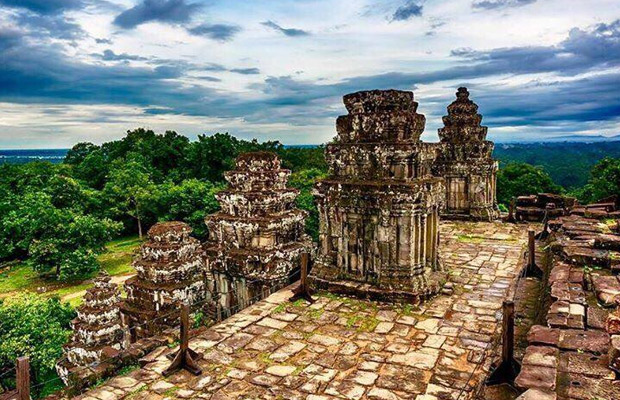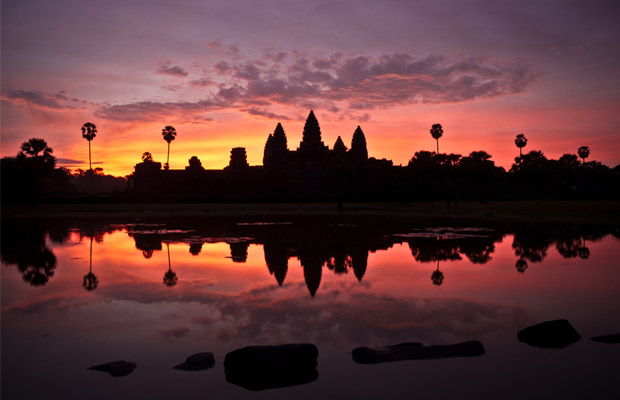Phnom Kulen Linga River
The 1,000-lingual river owes its name to the images of Hindu gods, their spouses and more than 1,000 slings carved into the bed and banks of the Siem Reap River in Phnom Kulen. The lanyards are a symbol of the essence of God Shiva and were built to purify the water of the river and make it fertile to then irrigate the rice fields.
The 1,000-lingual river owes its name to the images of Hindu gods, their spouses and more than 1,000 slings carved into the bed and banks of the Siem Reap River in Phnom Kulen. The lanyards are a symbol of the essence of God Shiva and were built to purify the water of the river and make it fertile to then irrigate the rice fields. Along with the slings, we find several sculptures on the river bank that represent various scenes and inscriptions. The most recurring scene is the re-creation of the fallen world in chaos. The sculptures and slings date back to the reign of King Udayadityavarman II and the workmanship and techniques used to create them more than a thousand years ago astonished archaeologists and scholars as the king changed course to sculpt the lanyards the bed of the river.
View Mores Temple Guide

Preah Ang Thom
Preah Ang Thom (Khmer: ព្រះអង្គ ធំ) is an 8-meter tall statue of the reclining Buddha that strikes nirvana. The statue is carved into a huge sandstone rock. Preah Ang Thom is the ...

Sambor Prei Kuk
Sambor Prei Kuk (Khmer: ប្រាសាទសំបូរព្រៃគុក, Prasat Sambor Prei Kuk) is an archaeological site in Cambodia, located in the province of Kampong Thom, 30 km north ...

Prasat Leak Neang
Prasat Leak Neang (Khmer's "Tower of the Hidden Virgin") is a small, 200 m east of Pre Rup, lying Prasat in Angkor. According to an inscription, the building dates from 960 and was built under ...

West Baray
The West Baray (Khmer: បារាយណ៍ទឹកថ្លា, Baray Teuk Thla) is a baron or reservoir, in Angkor, Cambodia, oriented to the east and west, located west of the walled city, ...

Neak Pean Temple
Neak Pean (or Neak Poan) [2] (Khmer: ប្រាសាទនាគព័ន្ធ) ("The intertwined serpents") in Angkor, Cambodia is an artificial island with a Buddhist temple on a circular ...

Bakong Temple
Bakong (Khmer: ប្រាសាទបាគង) is the first mountain of the sandstone temple built by the rulers of the Khmer empire in Angkor, near modern Siem Reap in Cambodia. In the last ...

Khmer Classical Dancing
The Grande Hotel in Angkor has a restaurant and stage by the river that features nightly performances of apsara style dancers. The show and dinner buffet is $ ...

Ta Keo
Ta Keo had to be the state temple of Jayavarman V, son of Rajendravarman, who had built the Pre Rup. Like Pre Rup, it has five sanctuary towers arranged in a quincunx, built at the highest level of ...

Siem Reap Bird Watch Day Tour
Find your bird specialist at your hotel and proceed with an air-conditioned car or minivan to the boats area. Transfer to a mini-boat, a special flat-bottom boat driven by experienced local drivers. ...

Phnom Kulen
The Phnom Kulen mountain range is located 30 km north of Angkor Wat. Its name means "mountain of lychees". [3] There is a sacred site at the top of the hill. Phnom Kulen is considered a sacred ...

Phnom Bakheng
Phnom Bakheng in Angkor, Cambodia, is a Hindu and Buddhist temple in the shape of a temple mountain. Dedicated to Shiva, it was built at the end of the 9th century, during the reign of King ...

Angkor Thom East Gate
The east gate of Angkor Thom was used as a location on the Tomb Raider, where the bandits entered the "tomb" pulling a giant polystyrene apsara. This is the most atmospheric of the gates of Angkor ...












